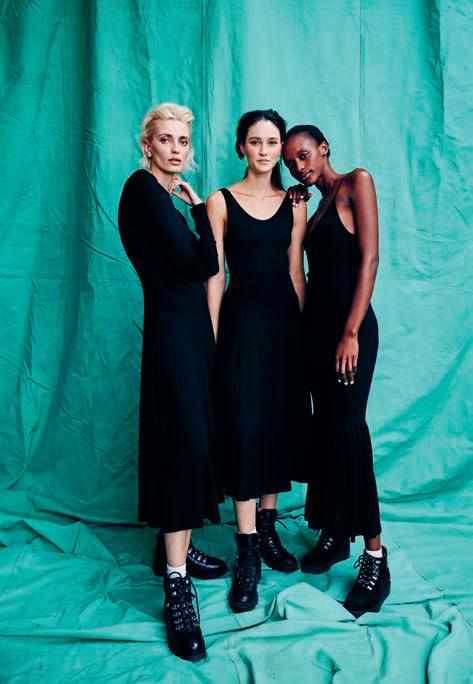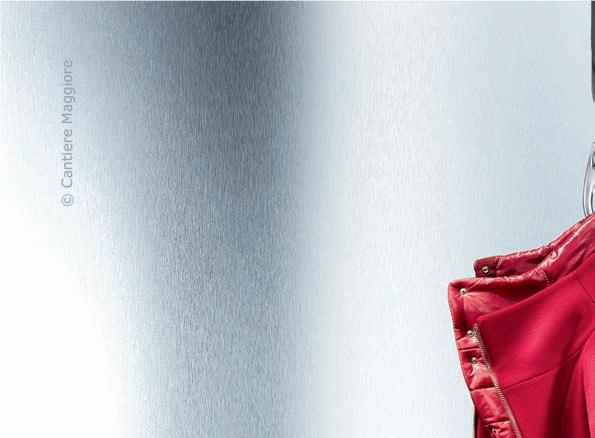
6 minute read
Profile Ninety Percent, the womenswear brand giving away most of its profits
Respect earned
Inside the sustainable womenswear label that gives away the majority of its profits
“T hey do what?” That’s the reaction you’ll likely get when you tell friends about Ninety Percent, and how the London-based clothing brand shares 90% of its distributed profits among charitable causes and those who make its collections happen. Another talking point is that customers decide which charity they want to support. All they have to do is vote using the unique code found on the care label of their new garment. Sharing profits, striving to empower everyone involved – it’s fashion, Jim, but not as we know it.
Ninety Percent was launched in 2018, but cofounder Shafiq Hassan says that discussions about its founding go back to 2005. “We were questioning how traditional big businesses were run, how they controlled the public and governments around the globe, how the system was exploitative to the planet, without giving much back,” he says. “We saw a disconnect between big business and customers, where the latter didn’t have a say in what the former did. There had to be another way. We wanted to give the maximum amount and not just pay lip service. We wanted to turn the traditional model on its head. Our concept is about making real change with our profits, where our customers know they’re part of a revolution.”
So, rather than shareholders being the main benefactors, the majority of profits are shared between four charities (Children’s Hope, War Child UK, Big Life Foundation and Wild Aid) and those making the clothes. “Everyone involved, at every stage, has to be empowered, from the people running the business, all the way to our customers,” says Hassan.
Sustainability is a much-bandied word in the fashion industry and, as a consumer, it can be difficult to unpick its meaning when there’s little consistency in its use. For Hassan, it’s clear: “Sustainability is what you start with and what you leave behind, with the impact you create. You should aim to make everything you touch better than what you started with.”
The brand only partners with companies that have sustainable processes embedded into their practice, whether they’re in Italy, Germany, Turkey, China or Bangladesh. Its focus is on organic cotton and Tencel (fibre made from wood-pulp), which it says are the better options currently available. All its textile mills and yarn suppliers are certified by the Global Organic Textile Standard, while Oeko-Tex certification means they are free from harmful chemicals. Ninety Percent’s key production partner in Bangladesh, Echotex, has a factory that’s LEED Platinum certified, and is seen as a pioneer in ethical and sustainable production.
“We need to change the culture of fashion and how we consume and use clothes,” says Hassan. “Human rights abuses and environmental degradation are rife. There’s a shocking lack of transparency and accountability across supply chains. We’re up against a tidal wave of unhealthy materials that have become the norm over the last 50 years. We’re all on a learning curve and we’re part of the global movement of brands, retailers, producers and consumers who are slowly turning the tide,” he continues. “In just a year and a half since our launch we’ve managed to make our collection’s raw materials 97% sustainable.”
Another aspect of sustainability is being able to create pieces with wardrobe staying power, which is down to the work of creative director Ben Matthews. His background is in buying, first at Arcadia followed by ten years at Net-aPorter where he rose to be buying manager, overseeing ready-to-wear across hundreds of brands. When he first heard Hassan’s concept, coming from this hardened business experience, his reaction was not unexpected. “He said he wanted to give his profits away. I was like, ‘righhhhht’. I actually thought he was joking,” Words Morag Bruce
Portrait Benjamin McMahon
Facing page Ben Matthews (left) creative director of Ninety Percent, and co-founder Shafiq Hassan (right)


Above Left to right: long-sleeve dress, tank dress and gathered hem dress, all made from Tencel; loopback jumper and Tencel dress

he laughs. “But the more I learned about it, the more I thought we could create something meaningful and effect real change.”

Hassan had the idea, but Matthews drove the brand’s aesthetic and its game-plan. “He gave me complete creative freedom, which was very trusting because I hadn’t done this before,” he says. “I knew how to market and sell brands, and how to second guess what customers will want in six months, but in my previous career, I had only dealt with the finished product. Here, it’s been about how to get an idea from your head into finished, sold garments. I built a team around me who are experts, and I was very honest with them about my experience.”
Lack of experience or not, in just 18 months, Ninety Percent has made impressive inroads. “It’s not just a new brand, it’s a new concept, so the sorts of stores we’re in now – Selfridges, Browns, Nordstrom and Net-a-Porter – is bonkers. We’re so grateful they’ve taken a punt on us,” says Matthews. From fitted dresses to oversized sweatshirts, the look and feel he landed on has the aims of the brand at its heart. “We’re not a conceptual fashion brand; what we do needs to be widereaching because, after all, the more we sell, the more we give back,” says Matthews. He describes the label’s aesthetic as European, clean, considered and friendly, with a modern femininity. “We’re not trend led, we wanted to be about slow fashion and wardrobe staples, pieces that don’t date,” he says. Hassan adds, “We’re passionate about the end products being of a very high standard, not something fleeting to end up in landfills. We want our products to have a long life.”

For Matthews, that the clothes are stylish and desirable is part of a bigger picture. “We aim to help change the relationship people have with buying clothes. I mean, I’m not saying we expect people to sit around and ponder them,” he smiles. “It’s just a good feeling to have a good story about something you’re wearing.” And have a story you’re proud to tell. Above Left to right: jumbo hoodie dress; oversized tee worn over V-neck dress


















